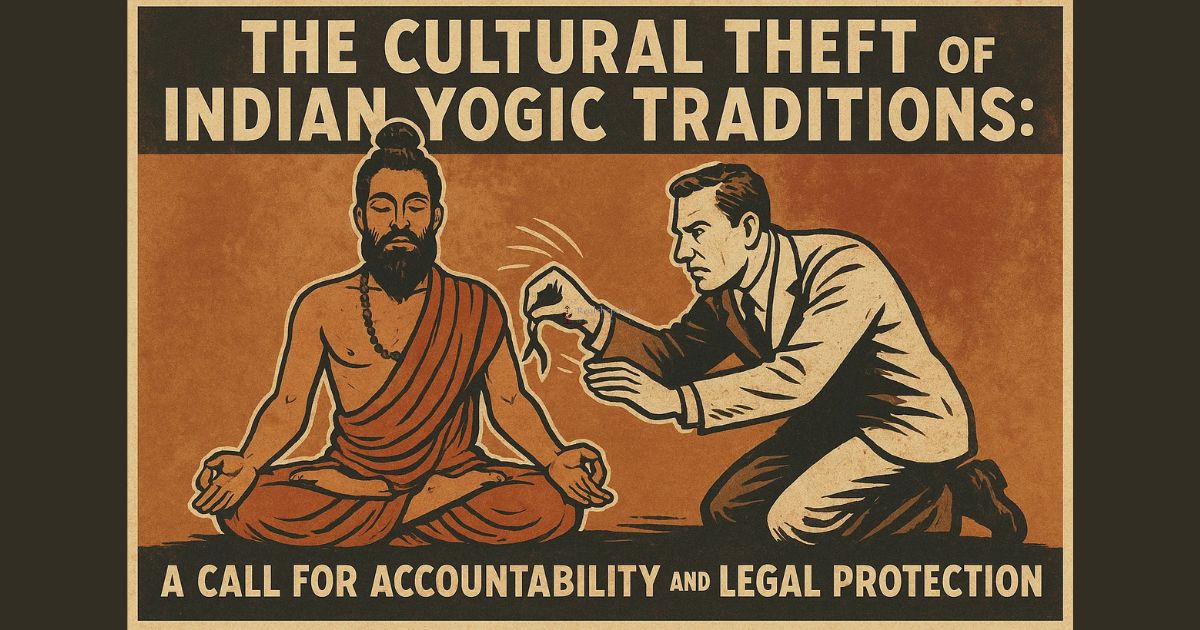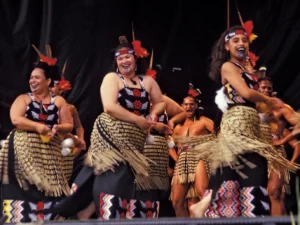India’s yogic traditions, spanning thousands of years, form a profound system for physical, mental, and spiritual well-being, rooted in ancient texts such as the Vedas, Upanishads, and Patanjali’s Yoga Sutras. Yoga is not merely a set of exercises but a holistic philosophy that integrates body, mind, and soul. However, the West has increasingly appropriated these traditions, repackaging them under new names like Pilates, breathwork (derived from pranayama), and non-sleep deep rest (NSDR, a rebranded yoga nidra), often without crediting their Indian origins. This article examines the extent of this appropriation, the reasons it persists, the dangers it poses, and proposes a legally binding framework to hold appropriators accountable for failing to acknowledge yoga’s roots.
The Extent of Appropriation

1. Pilates: A Derivative of Yoga
Pilates, marketed as a modern fitness system developed by Joseph Pilates in the early 20th century, draws heavily from yoga. Historical records indicate that Joseph Pilates studied yoga and incorporated its asanas (postures) and principles of core strength, flexibility, and mindful movement into his method. For instance, Pilates exercises like the “Hundred” resemble Navasana (Boat Pose), and the “Spine Stretch” mirrors Paschimottanasana (Seated Forward Bend). Yet, Pilates is rarely presented as an offshoot of yoga, instead being branded as a Western invention. This omission erases yoga’s influence and disconnects the practice from its cultural and philosophical origins.
2. Pranayama Rebranded as Breathwork
Pranayama, the yogic practice of breath control, is designed to regulate prana (life force) and promote mental clarity and spiritual awakening. Techniques like Anulom Vilom (alternate nostril breathing) and Kapalbhati (skull-shining breath), documented in texts like the Hatha Yoga Pradipika, have been practiced in India for millennia. In the West, these techniques are often repackaged as “breathwork,” marketed as secular tools for stress relief or performance enhancement. Methods like the Wim Hof technique or other breathwork programs borrow heavily from pranayama but rarely acknowledge its origins, presenting the practices as modern discoveries.
3. Yoga Nidra as Non-Sleep Deep Rest (NSDR)
Yoga nidra, or “yogic sleep,” is a meditative practice rooted in Tantric traditions, involving guided visualization and body awareness to induce deep relaxation and heightened consciousness. Described in texts like the Yoga Taravali, it is a sacred practice aimed at spiritual awakening. In the West, yoga nidra has been rebranded as “Non-Sleep Deep Rest” (NSDR), a term popularized by neuroscientist Andrew Huberman. Marketed as a science-backed technique for relaxation and productivity, NSDR omits any reference to its Indian roots, framing it as a Western innovation.
4. Other Appropriated Practices
The appropriation extends to:
- Meditation: Techniques like Vipassana and Dhyana are repackaged as “mindfulness” or “guided meditation” in apps like Headspace or Calm, often without crediting their Indian origins.
- Chanting and Mantras: The sacred practice of chanting Om or other mantras is reduced to “sound therapy” or “vibrational healing,” stripped of its spiritual context.
- Ayurveda-Inspired Practices: Elements of Ayurveda, such as dietary principles or abhyanga (self-massage), are co-opted into Western trends like “clean eating” or “dry brushing” without acknowledgment.
Why the West Continues to Appropriate
1. Colonial Legacy and Power Dynamics
The appropriation of yoga reflects a colonial mindset that views non-Western cultures as resources to be exploited. During British rule in India, yoga was often dismissed as primitive or superstitious. Today, the West continues this pattern by extracting yogic practices, repackaging them for Western audiences, and claiming intellectual ownership. This power imbalance allows Western cultures to redefine and profit from Indian traditions without accountability.
2. Commercialization and Market Demand
The global wellness industry, valued at over $4.5 trillion in 2023, thrives on commodifying yoga. By presenting yogic practices as secular, science-backed techniques, Western entrepreneurs make them accessible to consumers who may avoid “foreign” or “spiritual” practices. Pilates studios, breathwork workshops, and NSDR programs generate significant revenue, prioritizing profit over cultural integrity.
3. Cultural Ignorance and Erasure
Many Western practitioners lack awareness of the origins of the practices they teach, as yoga has been filtered through layers of Western reinterpretation. Yoga teacher training programs in the West often focus on physical postures, neglecting the philosophical and spiritual aspects, leading to a shallow understanding of the tradition. This ignorance facilitates the erasure of India’s contributions.
4. Scientific Validation as a Pretext
The West often justifies appropriation by claiming to “validate” yogic practices through science. Studies on breathwork or NSDR are used to legitimize these practices, while their Indian origins are ignored. This implies that Indian knowledge is only valuable when endorsed by Western science, reinforcing a Eurocentric worldview.
Why This Trend Is Dangerous
1. Erasure of Cultural Heritage
Appropriation erases India’s cultural and intellectual contributions, perpetuating colonial stereotypes that Indian traditions are inferior. For Indian practitioners, this feels like a theft of their heritage, as sacred practices are commodified and stripped of meaning.
2. Loss of Spiritual Depth
Yoga is a spiritual path aimed at self-realization. Secularizing practices like pranayama or yoga nidra diminishes their transformative potential, reducing them to superficial wellness trends focused on aesthetics or productivity.
3. Exploitation and Inequality
Western instructors, studios, and corporations profit from yogic practices, while Indian practitioners and communities receive little recognition or financial benefit. For example, Western yoga influencers earn millions through online courses, while traditional Indian yoga teachers often struggle economically.
4. Cultural Misrepresentation
Appropriation distorts the public’s understanding of yoga, reducing it to a fitness fad or stress-relief tool. This leads to cultural insensitivity, such as using Om on merchandise or trivializing spiritual practices in pop culture, disrespecting the beliefs of millions.
5. Risk of Harmful Misapplication
Without proper understanding, Western adaptations can lead to misuse. For example, pranayama techniques like Kapalbhati require careful instruction to avoid adverse effects, but Western breathwork classes often lack this rigor. Similarly, yoga nidra, when taught as NSDR, may lose its efficacy.
Recommended Read
A Legal Framework to Hold Appropriators Accountable
To address this cultural theft, a legally binding law should be enacted to hold individuals, organizations, and corporations accountable for appropriating Indian yogic traditions without crediting their origins. This framework would protect India’s cultural heritage and ensure respect for its contributions. Below is a detailed proposal for such a law:
Proposed Legal Framework
1. Legislation Title: The Indian Cultural Heritage Protection Act (ICHPA)
This act would specifically address the appropriation of Indian yogic and traditional knowledge systems, including yoga, pranayama, yoga nidra, and Ayurveda-derived practices.
2. Scope and Definitions
- The law would define “yogic traditions” as practices originating from Indian texts, traditions, or oral knowledge systems, including but not limited to yoga asanas, pranayama, yoga nidra, meditation, chanting, and Ayurveda-based practices.
- Appropriation would be defined as the use, teaching, or commercialization of these practices without explicit acknowledgment of their Indian origins in all related materials, teachings, or marketing.
3. Mandatory Acknowledgment
- Any individual, organization, or corporation teaching, promoting, or selling products based on yogic traditions must include a clear statement acknowledging their Indian origins. For example: “This practice is derived from traditional Indian yoga, as documented in ancient texts like the Yoga Sutras.”
- Failure to provide this acknowledgment in teacher training programs, classes, workshops, online content, or merchandise would constitute a violation.
4. Penalties for Non-Compliance
- Fines: Violators would face graduated fines based on the scale of appropriation. For example, individual instructors could face fines of $1,000–$5,000 per instance, while corporations (e.g., wellness brands or fitness chains) could face fines of $10,000–$100,000 per violation.
- Cease-and-Desist Orders: Courts could issue orders to halt the teaching or commercialization of appropriated practices until compliance is met.
- Reputational Sanctions: Violators’ names could be published on a public registry maintained by a cultural heritage protection body, deterring future violations.
- Restitution: A portion of fines could be redirected to Indian cultural organizations or yoga schools to support the preservation of traditional practices.
5. Enforcement Mechanism
- International Cooperation: The law would be enforced within India and extended internationally through bilateral agreements with countries like the United States, Canada, and European nations, where yoga appropriation is prevalent. These agreements could leverage trade or cultural exchange frameworks.
- Cultural Heritage Protection Body: A dedicated body, such as an expanded Traditional Knowledge Digital Library (TKDL) under the Indian Ministry of AYUSH, would monitor compliance, investigate complaints, and issue penalties.
- Public Reporting System: A platform would allow individuals to report instances of appropriation, ensuring community-driven accountability.
6. Exemptions and Fair Use
- The law would allow for fair use in academic or research contexts, provided proper attribution is given.
- Personal, non-commercial practice of yoga would be exempt, as the focus is on public teaching and commercialization.
Implementation Challenges
- Global Enforcement: Enforcing the law internationally would require cooperation from foreign governments, which may resist due to differing views on intellectual property and cultural heritage.
- Defining Appropriation: Clear criteria would be needed to distinguish between legitimate adaptation and appropriation, avoiding overly broad applications that could stifle genuine innovation.
- Awareness and Compliance: Many Western practitioners may be unaware of their obligations, necessitating education campaigns alongside enforcement.
Precedents and Supporting Mechanisms
- The Indian government has already taken steps to protect traditional knowledge through the TKDL, which documents practices like yoga to prevent patenting by foreign entities. For example, in 2009, the TKDL successfully blocked attempts to patent yoga poses in the United States.
- International frameworks, such as the Nagoya Protocol on Access and Benefit-Sharing, provide a model for protecting indigenous knowledge. India could advocate for similar protections for yoga under UNESCO’s Intangible Cultural Heritage framework.
- The law could draw inspiration from existing cultural protection laws, such as those protecting Indigenous art in Australia or Native American cultural practices in the United States.
Benefits of the Legal Framework
- Cultural Preservation: The law would ensure that India’s yogic heritage is recognized and respected globally.
- Economic Equity: By redirecting fines to Indian cultural organizations, the law would support communities that have preserved these traditions.
- Global Awareness: Mandatory acknowledgments would educate practitioners and consumers about yoga’s origins, fostering cultural sensitivity.
- Deterrence: Penalties would discourage flagrant appropriation, encouraging ethical engagement with Indian traditions.
Additional Steps to Stop Appropriation
Beyond legal measures, cultural and educational efforts are essential:
- Acknowledge Origins: Western instructors and brands must credit India in all yoga-related activities, from classes to marketing materials.
- Educate the Public: Indian scholars and practitioners can use social media and global platforms to highlight yoga’s history and counteract appropriation.
- Support Indian Practitioners: Consumers should prioritize learning from authentic Indian yoga teachers and supporting organizations like the Indian Ministry of AYUSH.
- Challenge Commercialization: Consumers can demand transparency from wellness brands, boycotting those that fail to respect yoga’s roots.
- Promote Cultural Sensitivity: Western practitioners should approach yoga with humility, learning its spiritual and cultural dimensions.
Conclusion
The appropriation of Indian yogic traditions by the West is a form of cultural theft that erases India’s contributions, exploits its heritage, and distorts the essence of yoga. Practices like Pilates, breathwork, and NSDR owe their existence to yoga, yet their Indian origins are rarely acknowledged. This trend, driven by colonial legacies, commercialization, and cultural ignorance, undermines the integrity of yoga and harms the communities that have preserved it for centuries. A legally binding framework, such as the proposed Indian Cultural Heritage Protection Act, would hold appropriators accountable, ensuring that yoga’s origins are respected. Combined with education, advocacy, and cultural sensitivity, this law could reclaim yoga’s narrative and protect India’s sacred heritage for future generations.









































